Download From http://bbs.infoeach.com
ﺔﻴﺒﺭﻌﻟﺍ ﺞﻴﻠﺨﻟﺍ لﻭﺩﻟ ﻥﻭﺎﻌﺘﻟﺍ ﺱﻠﺠﻤ لﻭﺩﻟ ﺱﻴﻴﻘﺘﻟﺍ ﺔﺌﻴﻫ
GCC STANDARDIZATION ORGANIZATION (GSO)
:
ﻉﻭﺭﺸﻤ
ﻲﺌﺎﻬﻨ
GSO 2/1 /FDS/ 22179 : 2012
ISO 22179:2009
(
ﺔﻋﺮﺴﻟا ﺖﻴﺒﺜﺗ
)
ﺔﻋﺮﺴﻟا
ﻢﻜﺤﺘﻟا تﺎﺌﻴﻬﻣ ﻲﻓ ﺔﻋﺮﺴﻠﻟ ﻞﻣﺎﻜﻟا ىﺪﻤﻟا
ﻢﻈﻧ
-
ﺔﻴآﺬﻟا ﻞﻘﻨﻟا ﻢﻈﻧ
ﻲﻓ
رﺎﺒﺘﺧﻻا تاءاﺮﺟإ
ءاو
دﻷا
تﺎﺒﻠﻄﺘﻣ
–
Intelligent transport systems -- Full speed range adaptive cruise
control (FSRA) systems -- Performance requirements and test
procedures
ﺩﺍﺩﻋﺇ
ﺕﺍﺭﺎﻁﻹﺍﻭ ﺕﺎﺒﻜﺭﻤﻟﺍ ﺕﺎﻔﺼﺍﻭﻤ ﻉﺎﻁﻘﻟ ﺔﻴﻋﺭﻔﻟﺍ
ﺔﻴﺠﻴﻠﺨﻟﺍ ﺔﻴﻨﻔﻟﺍ ﺔﻨﺠﻠﻟﺍ
ﺎﻬﻨﺈﻓ ﻙﻟﺫﻟ ،ﺎﻬﻨﺄﺸﺒ ﺕﺎﻅﻭﺤﻠﻤﻟﺍﻭ ﻱﺃﺭﻟﺍ ﺀﺍﺩﺒﻹ ﺎﻬﻌﻴﺯﻭﺘ ﻡﺘ ﺔﻴﺠﻴﻠﺨ ﺔﻴﺴﺎﻴﻗ ﺔ
ﻔﺼﺍﻭﻤﻟ ﻉﻭﺭﺸـﻤ ﺔﻘﻴـﺜﻭﻟﺍ ﻩﺫـﻫ
ﺱﻠﺠﻤ ﻥﻤ ﺎﻫﺩﺎﻤﺘﻋﺍ ﺩﻌﺒ ﻻﺇ ﺔﻴﺠﻴﻠﺨ ﺔﻴﺴﺎﻴﻗ ﺔﻔﺼﺍﻭﻤﻜ ﺎﻬﻴﻟﺇ ﻉﻭﺠﺭﻟﺍ ﺯﻭﺠﻴ ﻻﻭ ،لﻴﺩﺒﺘﻟﺍﻭ ﺭـﻴﻴﻐﺘﻠﻟ ﺔـﻀﺭﻋ
ﺔﺌﻴﻬﻟﺍ ﺓﺭﺍﺩﺇ
.
Download From http://bbs.infoeach.com
�
Download From http://bbs.infoeach.com
ﻡﻴﺩﻘﺘ
Foreword
ﻀﻋ ﻲﻓ ﻡﻀﺘ ﺔﻴﻤﻴﻠﻗﺇ ﺔﺌﻴﻫ ﺔﻴﺒﺭﻌﻟﺍ ﺞﻴﻠﺨﻟﺍ لﻭﺩﻟ ﻥﻭﺎﻌﺘﻟﺍ ﺱﻠﺠﻤ لﻭﺩﻟ ﺱﻴﻴﻘﺘﻟﺍ ﺔﺌـﻴﻫ
ﺔﻴﻨﻁﻭﻟﺍ ﺓﺯﻬﺠﻷﺍ ﺎﻬﺘﻴﻭ
ﺔﻴﺠﻴﻠﺨﻟﺍ ﺔﻴﺴﺎﻴﻘﻟﺍ ﺕﺎﻔﺼﺍﻭﻤﻟﺍ ﺩﺍﺩﻋﺇ ﺔﺌﻴﻬﻟﺍ ﻡﺎﻬﻤ ﻥﻤﻭ ، ﺔﻴﺒﺭﻌﻟﺍ ﺞﻴﻠﺨﻟﺍ لﻭﺩ ﻲـﻓ ﺱﻴـﻴﺎﻘﻤﻟﺍﻭ ﺕﺎﻔـﺼﺍﻭﻤﻠﻟ
.
ﺔﺼﺼﺨﺘﻤ ﺔﻴﻨﻓ ﻥﺎﺠﻟ ﺔﻁﺴﺍﻭﺒ
ﻡﻗﺭ ﺔﻴﻨﻔﻟﺍ ﺔﻨﺠﻠﻟﺍ لﻤﻋ ﺞﻤﺎﻨﺭﺒ ﻥﻤﻀ ﺔﻴﺒﺭﻌﻟﺍ ﺞﻴﻠﺨﻟﺍ لﻭﺩﻟ ﻥﻭﺎﻌﺘﻟﺍ ﺱﻠﺠﻤ لﻭﺩﻟ ﺱﻴﻴﻘﺘﻟﺍ ﺔﺌﻴﻫ ﺕﻤﺎﻗ ﺩﻗﻭ
١ "
ﺔﻴﻟﻭﺩﻟﺍ
ﻲـﻓ
.
ﺱﻴـﻴﻘﺘﻠﻟ
ﺔﻴﻠﺼﻷﺍ ﺎﻬﺘﻐﻠﺒ ﺔﻴﺠﻴﻠﺨ ﺔﻴﺴﺎﻴﻗ ﺔﻔﺼﺍﻭﻤﻜ
ﻡﻗﺭ ﺔﺌﻴﻬﻟﺍ
٢ –
ﺔﻴﺴﺎﻴﻘﻟﺍ ﺔﻔﺼﺍﻭﻤﻟﺍ ﻲﻨﺒﺘﺒ
ﻡﻜﺤﺘﻟﺍ ﺕﺎﺌﻴﻬﻤ ﻲﻓ ﺔﻋﺭﺴﻠﻟ لﻤﺎﻜﻟﺍ ﻯﺩﻤﻟﺍ
ﺔﻴﻜﺫﻟﺍ لﻘﻨﻟﺍ ﻡﻅﻨ
( "
ﺔﻴﻟﻭﺩﻟ
" –
ﺼﺃ ﻲﺘﻟﺍﻭ
ﺀﺍﺩﻷﺍ
ﺕﺎﺒﻠﻁﺘﻤ
ﺔﻔﺼﺍﻭﻤﻟﺍ ﻩﺫﻫ ﺕﺩﻤﺘﻋﺍ ﺩﻗﻭ
ﺔﻔﺼﺍﻭﻤﻟﺍ ﻩﺫﻫ ﻉﻭﺭﺸﻤ ﺩﺍﺩﻋﺈﺒ
ﺩﻭﻌﺴﻟﺍ ﺔﻴﺒﺭﻌﻟﺍ ﺔﻜﻠﻤﻤﻟﺍ
.
ﺔﻴ
)
ﺕﻤﺎﻗﻭ
(
ﺓﺭﺍﺩﺇ ﺱﻠﺠﻤ ﻉﺎﻤﺘﺠﺍ ﻲﻓ ﻙﻟﺫﻭ
ﺎﻬﻴﻠﻋ ﺔﻴﻨﻓ ﺕﻼﻴﺩﻌﺘ ﺔﻴﺃ لﺎﺨﺩﺇ ﻥﻭﺩ
ﺦﻴﺭﺎﺘﺒ ﺩﻘﻋ ﻱﺫﻟﺍ ،
ﻕﻓﺍﻭﻤﻟﺍ ، ـﻫ
/ /
/ /
ﺕﺍﺭﺎﻁﻹﺍﻭ ﺕﺎﺒﻜﺭﻤﻟﺍ ﺕﺎﻔﺼﺍﻭﻤ ﻉﺎﻁﻘﻟ ﺔﻴﻋﺭﻔﻟﺍ ﺔﻴـﺠﻴﻠﺨﻟﺍ
ﺔﻴـﻨﻔﻟﺍ ﺔﻨـﺠﻠﻟﺍ
٢٠٠٩
٢٢١٧٩
ﻭﺯﻴﺁ
ﻡﻗﺭ
:
)
( –
ﺔﻋﺭﺴﻟﺍ ﺕﻴﺒﺜﺘ
ﺔﻋﺭﺴﻟﺍ
)
ﺭﺎﺒﺘﺨﻻﺍ ﺕﺍﺀﺍﺭﺠﺇ
ﻡﻅﻨ
-
ﻭ
( )
ﺍ ﺔﻨﺠﻠﻟﺍ
"
ﺎﻬﺘﺭﺩ
"
ﻡ.
GCC Standardization Organization (GSO) is a regional Organization which
consists of the National Standards Bodies of GCC member States. One of GSO
main functions is to issue Gulf Standards through specialized technical committees
(TCs).
GSO through the technical program of committee TC No.2-1: "The Gulf technical
Subcommittee for vehicles and tyres standards” has adopted the European Standard
No. : (ISO 22179: 2009) “Intelligent transport systems -- Full speed range adaptive
cruise control (FSRA) systems -- Performance requirements and test procedures "
issued by (International Committee for Standardization) in its original language.
The Draft Standard has been prepared by (Kingdom of Saudia Arabia).This
standard has been approved as Gulf Standard without any technical modifications
by GSO Board of Directors in its meeting No..../.... …….held on / / / H , /
/ G
Download From http://bbs.infoeach.com
�
Download From http://bbs.infoeach.com
INTERNATIONAL
STANDARD
ISO
22179
First edition
2009-09-01
Intelligent transport systems — Full
speed range adaptive cruise control
(FSRA) systems — Performance
requirements and test procedures
Systèmes intelligents de transport — Systèmes de commande de
croisière adaptatifs à la gamme entière de vitesse (FSRA) — Exigences
de performance et méthodes d'essai
Download From http://bbs.infoeach.com
Reference number
ISO 22179:2009(E)
© ISO 2009
�
ISO 22179:2009(E)
Download From http://bbs.infoeach.com
PDF disclaimer
This PDF file may contain embedded typefaces. In accordance with Adobe's licensing policy, this file may be printed or viewed but
shall not be edited unless the typefaces which are embedded are licensed to and installed on the computer performing the editing. In
downloading this file, parties accept therein the responsibility of not infringing Adobe's licensing policy. The ISO Central Secretariat
accepts no liability in this area.
Adobe is a trademark of Adobe Systems Incorporated.
Details of the software products used to create this PDF file can be found in the General Info relative to the file; the PDF-creation
parameters were optimized for printing. Every care has been taken to ensure that the file is suitable for use by ISO member bodies. In
the unlikely event that a problem relating to it is found, please inform the Central Secretariat at the address given below.
COPYRIGHT PROTECTED DOCUMENT
© ISO 2009
All rights reserved. Unless otherwise specified, no part of this publication may be reproduced or utilized in any form or by any means,
electronic or mechanical, including photocopying and microfilm, without permission in writing from either ISO at the address below or
ISO's member body in the country of the requester.
ISO copyright office
Case postale 56 • CH-1211 Geneva 20
Tel. + 41 22 749 01 11
Fax + 41 22 749 09 47
E-mail copyright@iso.org
Web www.iso.org
Published in Switzerland
ii
Download From http://bbs.infoeach.com
© ISO 2009 – All rights reserved
�
Download From http://bbs.infoeach.com
ISO 22179:2009(E)
Contents
Page
Foreword ............................................................................................................................................................iv
Introduction.........................................................................................................................................................v
Scope......................................................................................................................................................1
1
2
Normative references............................................................................................................................1
Terms and definitions ...........................................................................................................................1
3
Symbols and abbreviated terms ..........................................................................................................3
4
5
Classification .........................................................................................................................................4
Requirements.........................................................................................................................................5
6
6.1
Basic control strategy...........................................................................................................................5
6.2
Functionality ..........................................................................................................................................5
6.3
Basic driver interface and intervention capabilities ..........................................................................9
Operational limits ................................................................................................................................10
6.4
6.5
Activation of brake lights....................................................................................................................12
Failure reactions..................................................................................................................................12
6.6
7
Performance evaluation test methods ..............................................................................................13
Environmental conditions ..................................................................................................................13
7.1
Test target specification .....................................................................................................................13
7.2
7.3
Automatic “stop” capability test........................................................................................................14
7.4
Target acquisition range test .............................................................................................................15
Target discrimination test...................................................................................................................16
7.5
7.6
Curve capability test ...........................................................................................................................18
Annex A (normative) Technical information ..................................................................................................21
Bibliography......................................................................................................................................................27
© ISO 2009 – All rights reserved
Download From http://bbs.infoeach.com
iii
�
Download From http://bbs.infoeach.com
ISO 22179:2009(E)
Foreword
ISO (the International Organization for Standardization) is a worldwide federation of national standards bodies
(ISO member bodies). The work of preparing International Standards is normally carried out through
ISO technical committees. Each member body interested in a subject for which a technical committee has
been established has the right to be represented on that committee. International organizations, governmental
and non-governmental, in liaison with ISO, also take part in the work. ISO collaborates closely with the
International Electrotechnical Commission (IEC) on all matters of electrotechnical standardization.
International Standards are drafted in accordance with the rules given in the ISO/IEC Directives, Part 2.
The main task of technical committees is to prepare International Standards. Draft International Standards
adopted by the technical committees are circulated to the member bodies for voting. Publication as an
International Standard requires approval by at least 75 % of the member bodies casting a vote.
Attention is drawn to the possibility that some of the elements of this document may be the subject of patent
rights. ISO shall not be held responsible for identifying any or all such patent rights.
ISO 22179 was prepared by Technical Committee ISO/TC 204, Intelligent transport systems.
iv
Download From http://bbs.infoeach.com
© ISO 2009 – All rights reserved
�
Download From http://bbs.infoeach.com
ISO 22179:2009(E)
Introduction
The main system function of full speed range adaptive cruise control (FSRA) is to control vehicle speed
adaptively to a forward vehicle by using information about:
a) distance to forward vehicles,
b)
the motion of the subject (FSRA equipped) vehicle, and
c) driver commands (see Figure 1).
Based upon the information acquired, the controller (identified as “FSRA control strategy” in Figure 1) sends
commands to actuators that carry out its longitudinal control strategy, and sends status information to the
driver.
Subject vehicle
motion determination
Acquisition of
driver commands
Detection and ranging
of forward vehicles
FSR A
control strategy
Actuators for
longitudinal control
Driver information
Environment
Vehicle
Driver
Figure 1 — Functional FSRA elements
The goal of FSRA is partial automation of longitudinal vehicle control to reduce drivers’ workload.
This International Standard may be used as a system level standard by other standards, which extend FSRA
to a more detailed standard, e.g. for specific detection and ranging-sensor concepts or higher levels of
functionality. Issues such as specific requirements for the detection and ranging sensor function and
performance or communication links for co-operative solutions are not considered in this International
Standard.
© ISO 2009 – All rights reserved
Download From http://bbs.infoeach.com
v
�
Download From http://bbs.infoeach.com
Download From http://bbs.infoeach.com
�
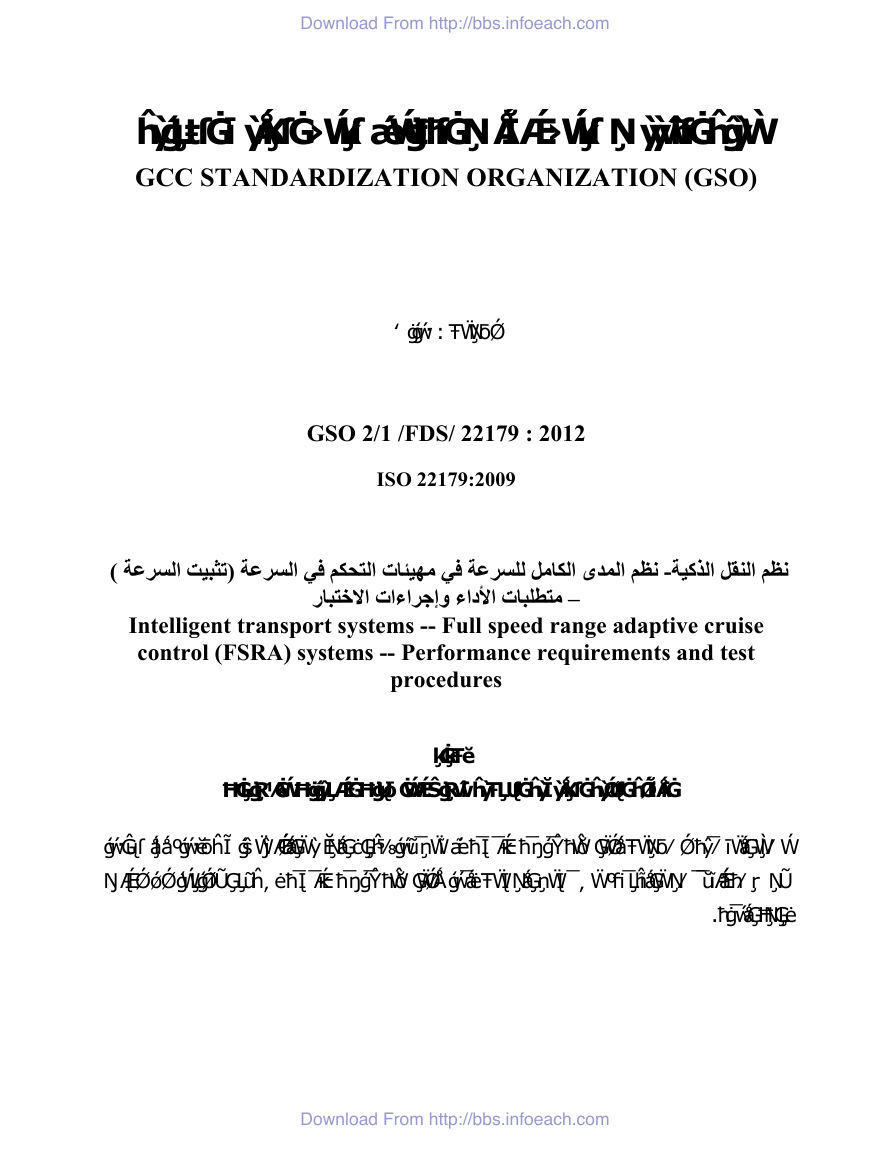
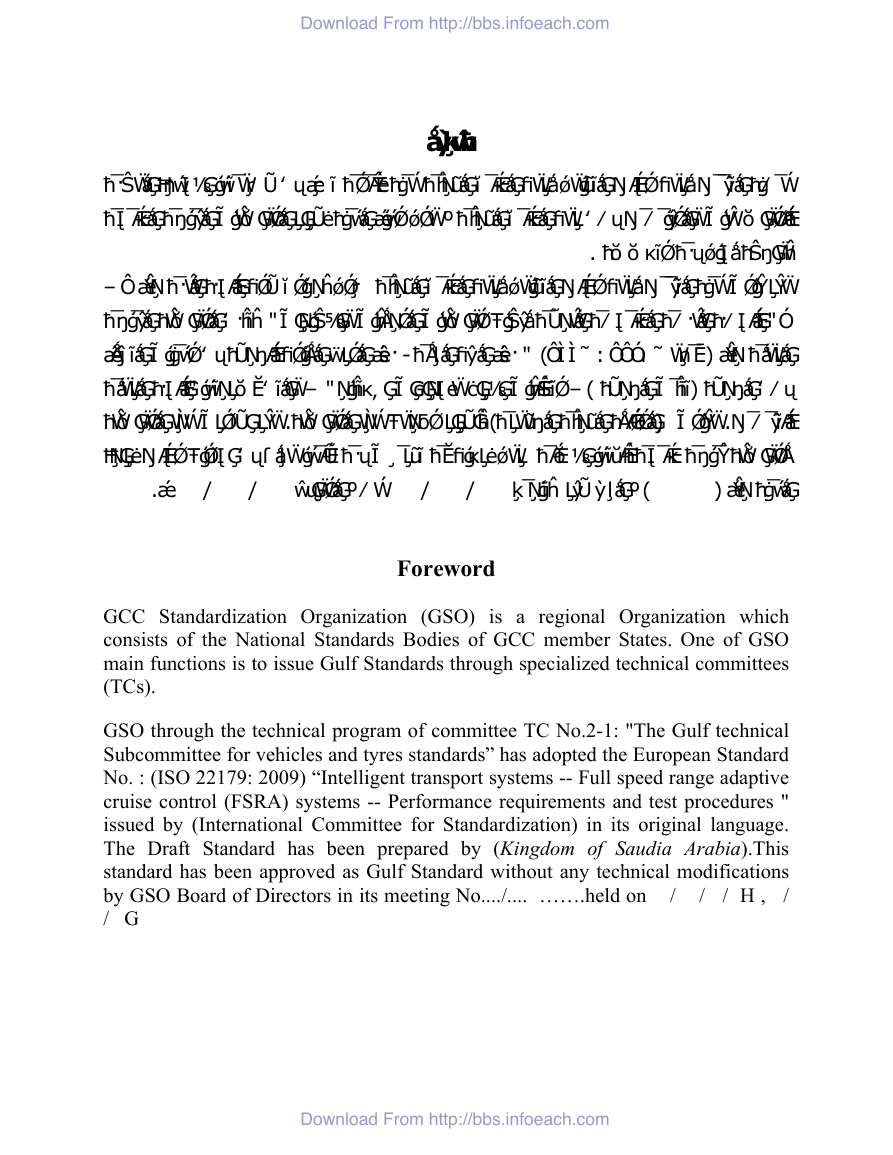
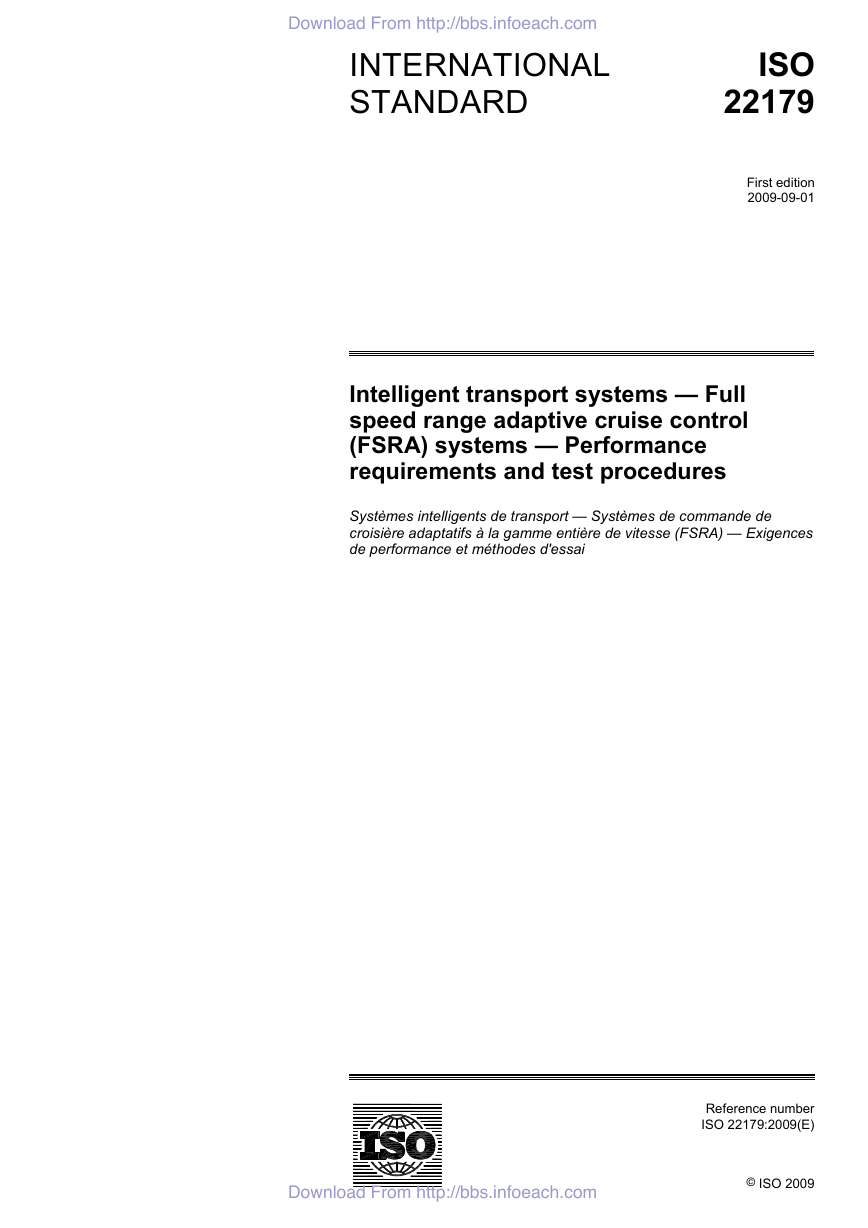
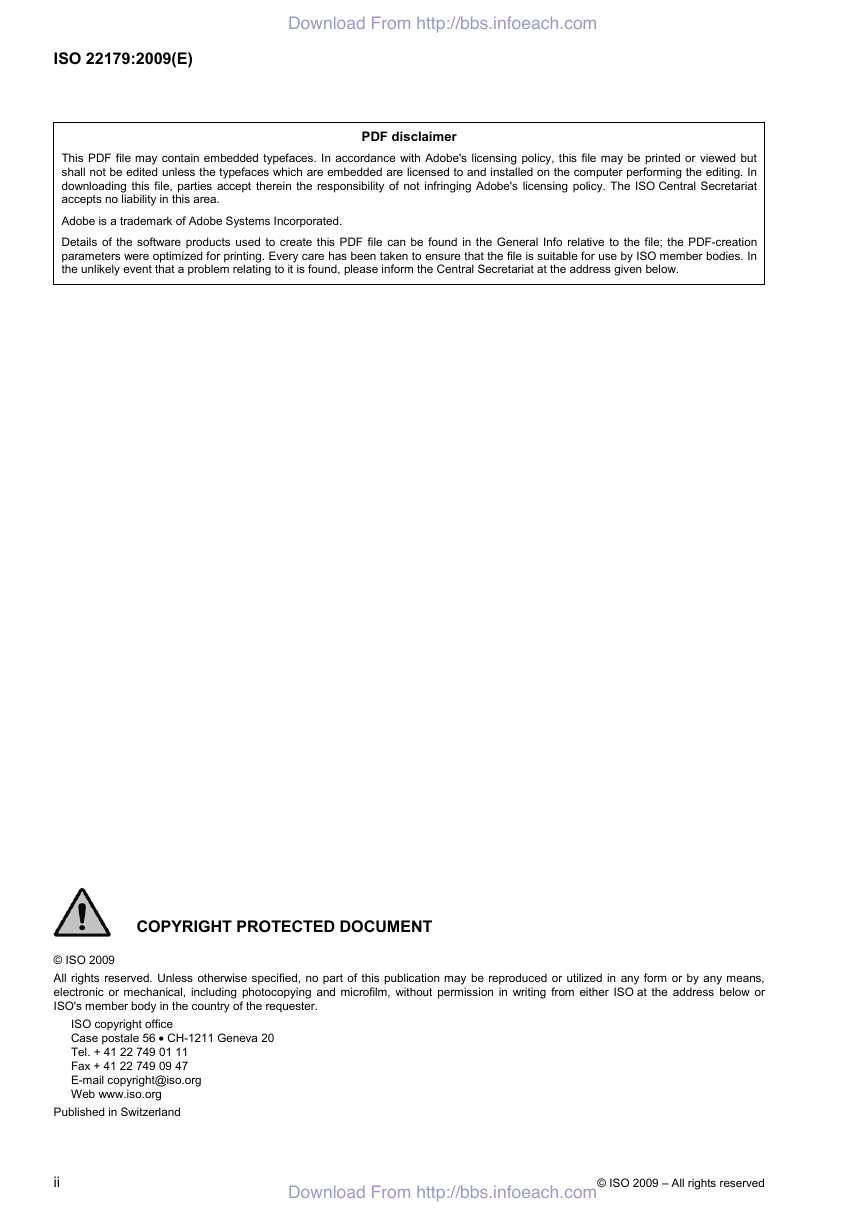
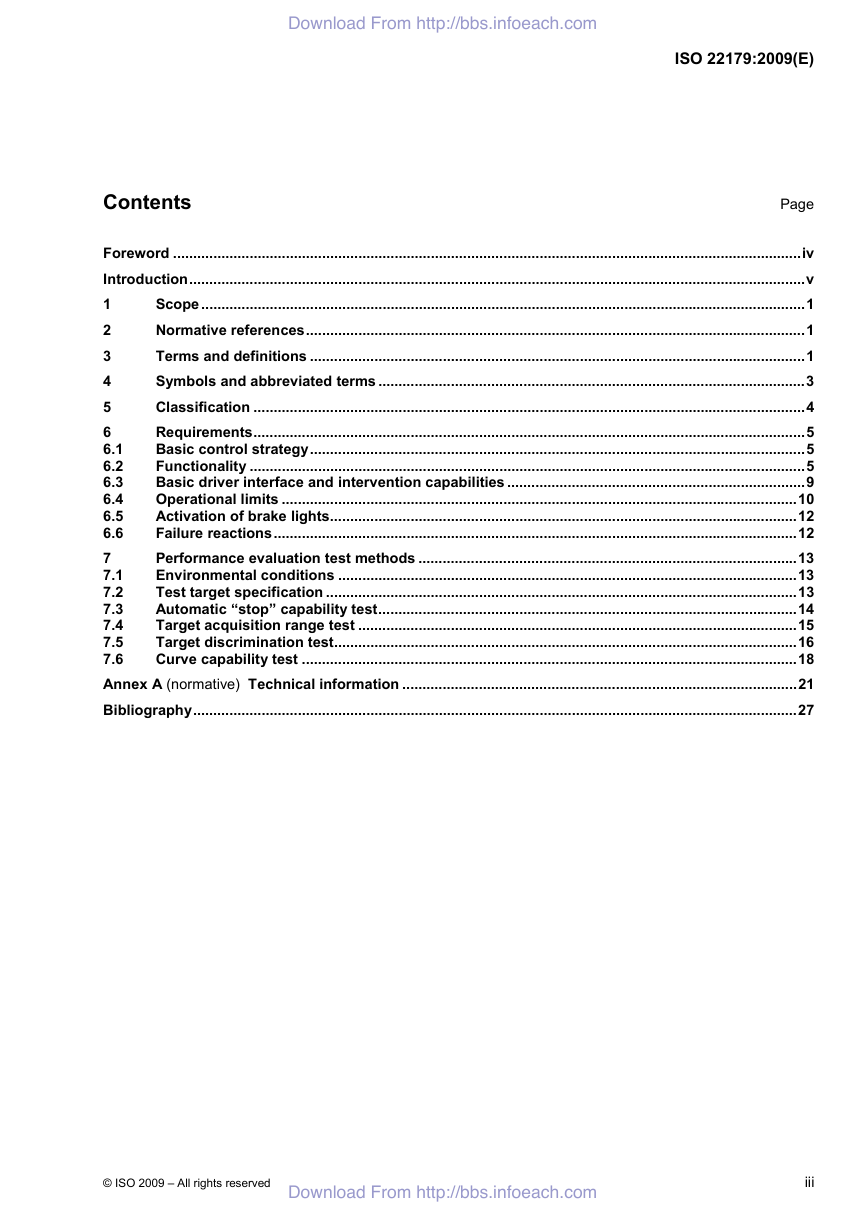
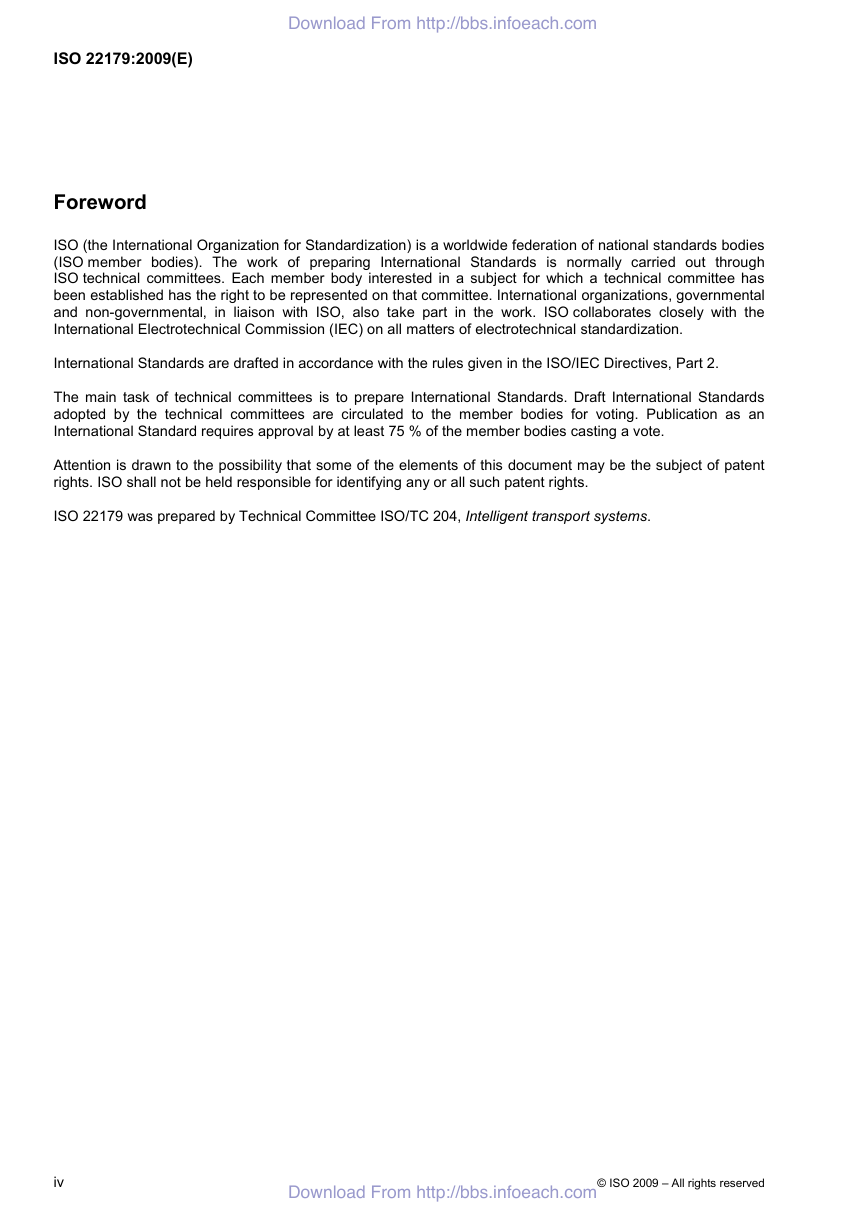
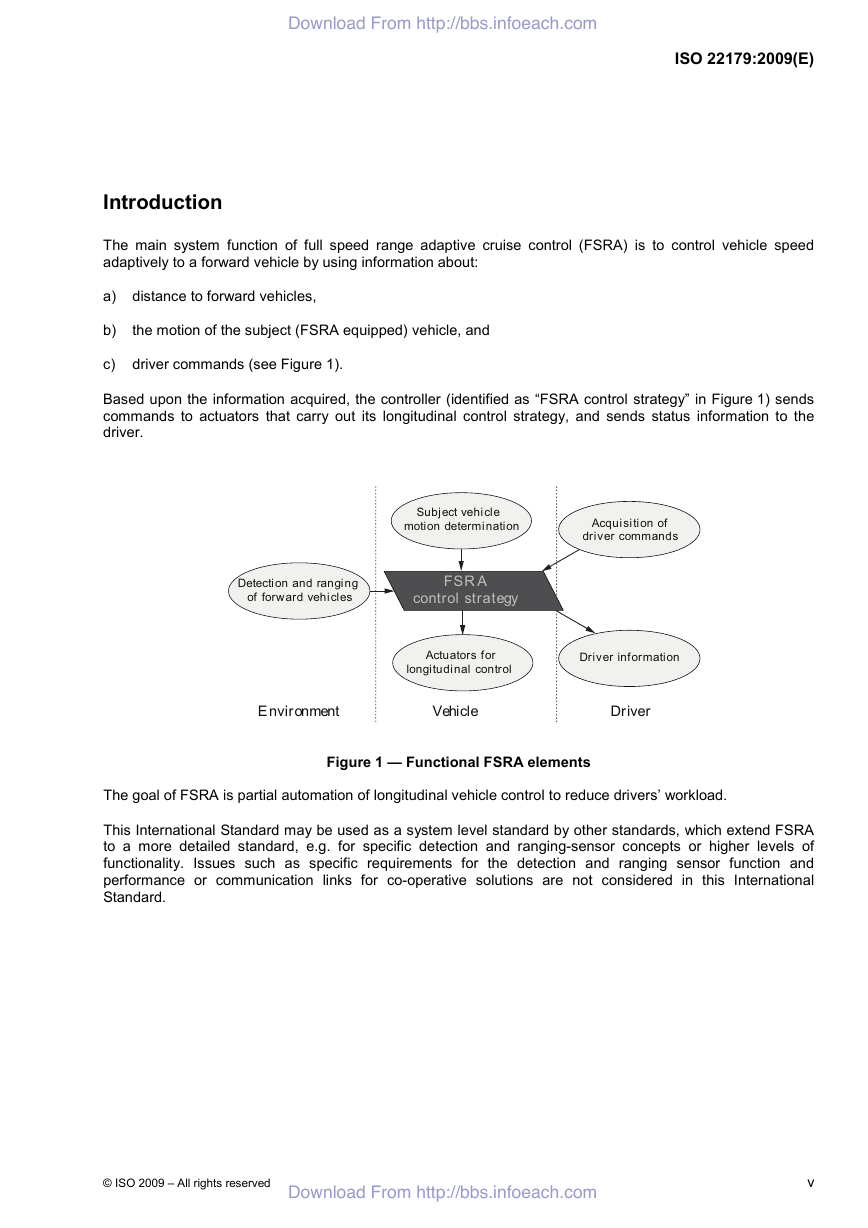









 2023年江西萍乡中考道德与法治真题及答案.doc
2023年江西萍乡中考道德与法治真题及答案.doc 2012年重庆南川中考生物真题及答案.doc
2012年重庆南川中考生物真题及答案.doc 2013年江西师范大学地理学综合及文艺理论基础考研真题.doc
2013年江西师范大学地理学综合及文艺理论基础考研真题.doc 2020年四川甘孜小升初语文真题及答案I卷.doc
2020年四川甘孜小升初语文真题及答案I卷.doc 2020年注册岩土工程师专业基础考试真题及答案.doc
2020年注册岩土工程师专业基础考试真题及答案.doc 2023-2024学年福建省厦门市九年级上学期数学月考试题及答案.doc
2023-2024学年福建省厦门市九年级上学期数学月考试题及答案.doc 2021-2022学年辽宁省沈阳市大东区九年级上学期语文期末试题及答案.doc
2021-2022学年辽宁省沈阳市大东区九年级上学期语文期末试题及答案.doc 2022-2023学年北京东城区初三第一学期物理期末试卷及答案.doc
2022-2023学年北京东城区初三第一学期物理期末试卷及答案.doc 2018上半年江西教师资格初中地理学科知识与教学能力真题及答案.doc
2018上半年江西教师资格初中地理学科知识与教学能力真题及答案.doc 2012年河北国家公务员申论考试真题及答案-省级.doc
2012年河北国家公务员申论考试真题及答案-省级.doc 2020-2021学年江苏省扬州市江都区邵樊片九年级上学期数学第一次质量检测试题及答案.doc
2020-2021学年江苏省扬州市江都区邵樊片九年级上学期数学第一次质量检测试题及答案.doc 2022下半年黑龙江教师资格证中学综合素质真题及答案.doc
2022下半年黑龙江教师资格证中学综合素质真题及答案.doc